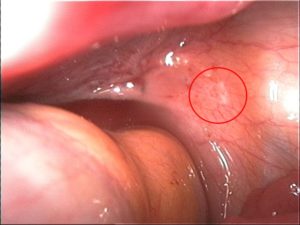When it comes to women’s health, it is very common to hear about diseases involving the uterus. As one of the main organs in a woman’s body and also one of the most sensitive, any change in any part of it can bring complications to a woman’s life.
This is the case with intestinal endometriosis, a disease that, although it does not directly affect the uterus, exists because of it. In this text, we will talk about why this disease occurs, its main symptoms, causes, treatments, and even the possible complications it can bring to your life.
What is Intestinal Endometriosis?
As we mentioned earlier, this is a disease that affects only women. It occurs when the endometrium begins to develop around the walls of the intestine, causing difficulties in its functioning. The endometrium is the tissue that lines the inside of the uterus.
There are several types of endometriosis, but the intestinal type is one of the most severe and causes the greatest pain in women, precisely because it affects the digestive system and causes not only pain but also problems with bowel movements, which can lead to a series of other consequences. The lesions of this type of endometriosis usually appear as nodules and it is considered a deep endometriosis.
What Causes Intestinal Endometriosis?
It is still not known exactly why intestinal endometriosis occurs, nor endometriosis in general. What can be pointed out is that a woman is more likely to suffer from the disease if there is a family history, which leads many to think that one of the factors that leads to the disease is genetic.
But although a family history increases the chances of developing the disease, it does not mean a woman will necessarily suffer from endometriosis. Studies in this area still need to progress before we can state with certainty what really causes the disease.
Main Symptoms of Intestinal Endometriosis
Because it is a deeper disease and strikes women more strongly, the symptoms of intestinal endometriosis are also more noticeable. Some of the main symptoms are:
- Severe abdominal cramps
- Irregular menstrual cycle
- Diarrhea during menstruation
- Dyspareunia (Pain during sexual intercourse)
- Pain when urinating
- Difficulty evacuating
- Bleeding from the anus during menstruation
- Nausea and vomiting
Of course, not all cases present with all these symptoms, but it is necessary to evaluate most of them to reach the conclusion that it is a case of intestinal endometriosis. Remember that it is extremely important to see a doctor to find out how severe the disease is and what is the best way to treat it.
How is the Diagnosis Made?
Usually, when a woman visits a doctor because of her symptoms, the first analysis carried out is through standard gynecological exams, which do not detect the disease. The next step is then to perform imaging tests such as computed tomography and transvaginal ultrasound to identify whether there is a case of intestinal endometriosis and how severe it is.
With this information, a gynecologist can indicate the best treatment for the woman, as well as whether surgical intervention will be necessary.
Treatment for Intestinal Endometriosis
Treatment for the disease will depend on what stage it is in and how severe the symptoms are for the woman. What basically needs to be done is to remove the layer of endometrial tissue covering the intestine so that the organ can function normally again.
In the past, the solution for this type of problem was the complete removal of the uterus, which could cause several other problems in a woman’s life. However, thanks to advances in medicine, it is now possible to treat the disease without removing the organ.
The doctor will realize that, if the tissue has reached the intestine, it means the case of endometriosis is already more severe and usually surgical intervention is the best option. There is also a hormonal treatment option, which is often tried in less severe cases before resorting to surgery.
The surgery is complex and requires great care, as the doctor will have to remove small portions of tissue without damaging the organs. In some cases, just scraping may solve the problem, but in others, it may be necessary to make some incisions to remove the endometrial tissue.
Possible Complications
Intestinal endometriosis is a disease that can lead to some complications, mainly because intestinal endometriosis can recur at any time, even after surgery. That’s why it is necessary to have regular exams to ensure everything is fine with the woman’s health.
Another complication that is a major concern for women with this condition is difficulty getting pregnant. After having this disease, a woman needs to undergo several tests and consult a doctor to verify whether her pregnancy would be safe.
Having to deal with certain diseases is often a traumatic, negative experience that we don’t wish to go through in any way. However, it is something that many women face every year, and for this reason, it is necessary for us to know what intestinal endometriosis is and what are its effects on a woman’s body.
And even though there is still no completely objective form of prevention, it is important to pay attention to the signs to identify and treat the disease early. If this kind of problem unfortunately exists, we need to know what are the best ways to fight it.












